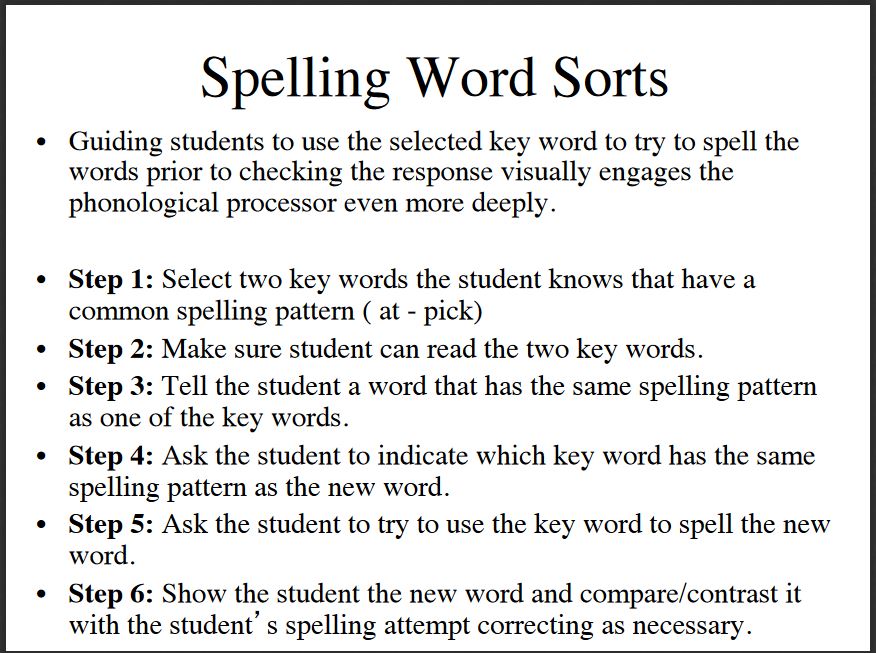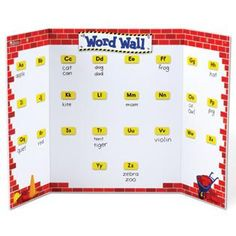“Students who read only by sight or the recognition of sight words are not likely to read text with comprehension above very beginning levels. To achieve successful reading with comprehension, students must have the ability to decode unfamiliar words.”
-Karen Erickson, Making Words for Students with Complex Instructional Needs
WORD IDENTIFICATION AND DECODING
What is word identification and decoding?
D uring word work, explicit instruction on the patterns of English spelling is provided. Students are taught how to use letter patterns to decode and spell new words when they are reading and writing.
uring word work, explicit instruction on the patterns of English spelling is provided. Students are taught how to use letter patterns to decode and spell new words when they are reading and writing.
At an emergent level, word work will focus on phonemic awareness with activities created to bring attention to rhyme (word endings), rhythm (memory), repetition, alliteration (word onsets), and predictability. For older emergent literacy learners, it is important to keep all activities age respectful.
Word work at a conventional level would include making words, word sorts and transfer, word wall activities and keyword decoding.
Which students would benefit from word identification and decoding?
How can students benefit from word identification and decoding?
- help students become strategic in reading words
- help students learn high frequency words needed for fluent, successful reading with comprehension
- teach students the skills required to decode and spell words they will use for reading and writing
- help students understand how words work.
How can we teach word identification and decoding?
- making words
- word sorts and transfer
- word wall activities
- keyword decoding

Every making words lesson has three parts. First students manipulate the letters to make words. This part of the lesson uses a spelling approach to help students learn letter sounds and how to segment words and blend letters. In the second part of the lesson, students sort words according to related words and rhyming patterns. During the transfer step, students are helped to use the related and rhyming words to spell new words.
The word wall is the focus at the end of every lesson, and is a critical component in helping students to use words they already know to help them read similar words they encounter in context or isolation. Word walls are visual displays of core words used to support students in their daily reading and writing. There are three levels of word wall lesson activities: introduce new word wall words, daily review of word wall words, and lesson review.
Making Words
Making Words (Cunningham & Hall, 1994, 1997) is an activity designed to teach students to look for spelling patterns in words and recognize the differences that result when a single letter is changed. Teachers guide students in manipulating their individual set of six to eight letters to create words. The six to eight letters can be arranged to form a “secret” word, but the teacher begins by guiding students through the creation of one-, two-, and three-letter words, and so on, through six- or eight-letter words from the set. The order is carefully selected to help students identify common spelling patterns and recognize the impact of changing one or two letters or the order of a set of letters.
As the students make the words, one student goes to the front of the room and uses a set of large letter cards to make the word for all to use for self-correction. The student also puts an index card with the word written on it in a pocket chart before quickly returning to their seat to make the next word. After all of the words have been made, the teacher guides the students in sort and transfer activities that help them focus on the spelling patterns in the words they have made. (Children with Disabilities: Reading & Writing the Four-Blocks Way, p. 119-120, 2006)



Sort and Transfer
In the sorting activity, the teacher begins by asking students to read all of the words that are in the pocket chart. The teacher then asks the students to group the words that rhyme and share a spelling pattern. She also asks students if they can sort the words based on any other similarities. Sometimes they sort the words for other features (for example, first or last letter, common vowel, length, meaning, or presence of a capital letter).
In the transfer step of the Making Words activity, the teacher writes other words on index cards. The teacher does not just ask students to read the words. Instead, the teacher asks them to tell which of the words they made would help them read the new word if they encountered it in text. Only after they have identified the correct spelling pattern and put the new word on the chart do they read the new word. (Children with Disabilities: Reading & Writing the Four-Blocks Way, p. 119-120, 2006)









Word Wall
The Word Wall is used in activities every day with new words added gradually and practiced repeatedly until they become words that students can read with automaticity, spell with accuracy, and use to read and spell unfamiliar words.
Beginning with lesson one and every tenth lesson after that, five words are added to the Word Wall. Words are displayed under the letter with which they begin and in the order they were introduced in the lessons (not in alphabetical order).
Students practice the words on the wall every day by clapping, chanting, and writing some of the words. They review the words using a variety of activities. Finally, teachers systematically support students in using the Word Wall in reading and writing activities throughout the day. (Children with Disabilities: Reading & Writing the Four-Blocks Way, p. 112, 2006)
Teachers who use a Word Wall successfully make the words on the wall easy for everyone in the classroom to see. Display the Word Wall in a highly visible location in the classroom and refer to it often to model identifying the key words and/or word patterns that give students the clues they need to decode unfamiliar words.
Portable word walls can be used by individual students so that they can add personal words as well as take them to refer to when in other classes.



Word Wall Activities
The interplay between writing and reading is especially important for the emergent reader and writer. We want to help students recognize high frequency words quickly and automatically while reading for meaning. Knowing them facilitates fluent reading and allows the reader to pay attention to new words.
Be a Mind Reader
The teacher thinks of a word on the wall and then gives five clues about that word. The students share a ‘guess’ for each clue.
Guess the Covered Word
Guess the Covered Word is an activity designed to teach students how to cross-check letter-sound-based decoding strategies with meaning. The teacher writes a sentence on the board covering one word in the sentence with two sticky notes. One note covers the letters preceding the first vowel (the onset) and the other note covers the rest of the word (the rime).
The teacher reads the sentence to the class, skipping the covered word, and asks the students to suggest words that would make sense in the sentence. The students provide guesses as the teacher writes them on the board. Then, the teacher removes the first sticky note to reveal the onset. The teacher then leads the students in checking each of their guesses to see which would still be possible given the onset that has been revealed. The students provide additional guesses starting with the revealed onset. When all of the words that fit both the meaning of the sentence and the letters have been guessed, the teacher removes the remaining sticky note to reveal the word. (Children with Disabilities: Reading & Writing the Four-Blocks Way, p. 122, 2006)


“The purposes of the Word Wall are to teach children to read and spell words with automaticity and accuracy,
while teaching them strategies to use the known words on the wall to read
and spell unknown words.”
–Karen Erickson and David Koppenhaver from Children With Disabilities: Reading and Writing the Four Blocks Way
Keyword Decoding
Keyword decoding can be thought of decoding by analogy. The goal is to have only a single keyword representing each of the common spelling patterns.
Teaching Key Words
Identify a single word for each of the high frequency spelling patterns on the list (see Keywords Planning Form). Try to identify words that the student can already read and words that are meaningful to the student. You should eventually have 37 keywords, but you can start teaching the strategy as soon as you have identified 6-8 that the student can read.
Known Words to Use in Teaching the Using Words You Know Strategy
While the student is learning to read the keywords, they should be learning to use keywords they do know to read novel words. Two specific strategies that could be used to help students learn the analogy based approach include word sorts and compare/contrast.
It is important to have the keyword list available to the student during all reading and writing activities. If the student is trying to decode an unfamiliar or unknown word, they can be prompted by asking, “Do you have a keyword that would help you?”
From the article, Keyword Decoding, Center for Literacy and Disability Studies


Resources:
 Systematic Sequential Phonics They Use by Patricia M. Cunningham
Systematic Sequential Phonics They Use by Patricia M. Cunningham
This book helps teachers provide activities in which students discover how words work. These activities include Making Words and Word Wall, which are included in each 5-lesson cycle. The Word Wall is a critical component of Systematic Sequential Phonics They Use. High frequency words are added as a part of every 5 lessons. Words are displayed under the letter in the alphabet in the order introduced. In addition to the classroom Word Wall, the students are given a take-home Word Wall each week that contains all the words on their classroom Word Wall. As a fun component to teaching phonics, students reinforce their learned skills with “Wordo”, a variation to the popular Bingo game.
© 2000. 192 pages.
*Systematic Sequential Phonics They Use is only available in a digital version. Search online to find the best price!
Based on Dr. Patricia Cunningham’s Making Words, Dr. Karen Erickson has developed 50 phonics lessons to introduce and build decoding
 skills for students with complex instructional needs. This resource also incorporates Dr. Cunningham’s approach to building decoding and spelling strategies featured in her book, Systematic Sequential Phonics They Use.
skills for students with complex instructional needs. This resource also incorporates Dr. Cunningham’s approach to building decoding and spelling strategies featured in her book, Systematic Sequential Phonics They Use.Where can I learn more about word identification and decoding?
This presentation highlights the importance of meaningful, purposeful communication in learning to read and write and connecting oral language to phonological awareness. Many interactive and engaging word wall and word activity examples are provided.
http://literacyforallab.ca/past-webinars
Working with Words
Alberta teachers demonstrate how they use word walls and related making word activities to build literacy skills of all students in their classroom, including students with significant disabilities. (Length: 7 minutes 2 seconds)
Video – Working with Words
Learning Guide – Working with Words
From Center for Literacy and Disability Studies:
Keyword-Decoding (including keywords planning form)
Keywords-Lessons-1-10